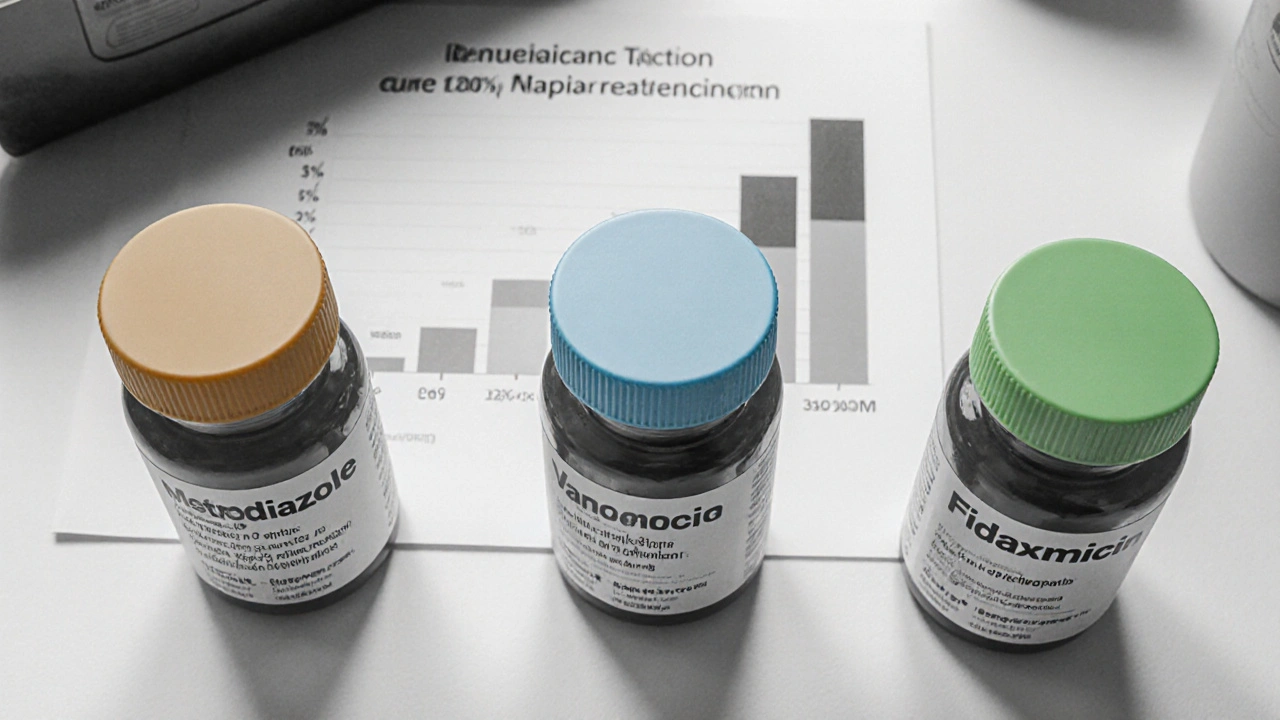CDI Treatment Selection Tool
Treatment Selection Guide
Select patient factors to determine the best treatment option for Clostridium difficile infection (CDI).
Recommended Treatment
Clinicians often wonder whether metronidazole still belongs in the toolbox for treating Clostridium difficile, a Gram‑positive, spore‑forming bacterium that causes severe diarrhea and colitis, often simply called CDI. The answer isn’t black‑and‑white; it depends on disease severity, patient history, local resistance patterns, and the latest guideline recommendations. This article walks you through the key facts, dosing tricks, and decision points so you can prescribe with confidence.
Understanding Clostridium difficile Infection (CDI)
CDI arises after the normal gut flora is disrupted, usually by broad‑spectrum antibiotics. The resulting overgrowth releases toxins A and B, leading to inflammation, watery stools, and sometimes life‑threatening megacolon. In the UK, CDI accounts for roughly 12,000 hospital‑acquired cases each year, with a mortality rate of 5‑10 percent in severe disease.
Why Metronidazole Became a First‑Line Choice
Metronidazole is an antibiotic belonging to the nitroimidazole class, active against anaerobic bacteria and certain protozoa. It works by entering bacterial cells, generating free radicals that damage DNA. Historically, its oral formulation was inexpensive, widely available, and showed good stool concentrations, making it an attractive first‑line option for mild‑to‑moderate CDI.
When Metronidazole Falls Short
Recent data show that metronidazole’s cure rates dip to 70‑80% for moderate disease and can be lower for severe cases. Recurrence-return of symptoms within eight weeks after successful treatment-occurs in 20‑30% of patients treated with metronidazole, compared with 15‑20% for vancomycin and 10‑12% for fidaxomicin.
Key scenarios where metronidazole is less suitable include:
- Severe CDI (white‑blood‑cell count >15,000µ/L or serum creatinine rise >1.5× baseline).
- Fulminant colitis requiring intensive care.
- Patients with a history of CDI recurrence within the past 3months.
- Regions with documented high metronidazole resistance.

Alternatives on the Table
Vancomycin is a glycopeptide antibiotic that stays largely in the gut when given orally, targeting Gram‑positive organisms, including C.difficile. It boasts cure rates of 85‑90% for moderate disease and 90‑95% for severe infection.
Fidaxomicin is a macrocyclic antibiotic with a narrow spectrum, sparing much of the normal flora. Its recurrence rate is consistently the lowest, around 10%. The downsides are higher cost and limited availability in some NHS trusts.
| Antibiotic | Spectrum | Route | Typical Cost (UK) | Recurrence Rate | Recommended for |
|---|---|---|---|---|---|
| Metronidazole | Anaerobes, protozoa | Oral | £5‑£10 per course | 20‑30% | Mild‑to‑moderate CDI |
| Vancomycin | Gram‑positive, including C.difficile | Oral | £150‑£200 per course | 15‑20% | Moderate‑to‑severe CDI |
| Fidaxomicin | Narrow, C.difficile specific | Oral | £1,200‑£1,500 per course | ≈10% | Severe CDI or high‑risk recurrence |
Dosage and Administration of Metronidazole
For adults with mild‑to‑moderate CDI, the standard regimen is 500mg orally four times daily for 10days. In patients who cannot swallow capsules, a liquid suspension (100mg/5ml) can be used at the same total daily dose.
Key administration tips:
- Take with food to reduce nausea, but avoid high‑fat meals that may delay absorption.
- Ensure the full 10‑day course is completed-even if symptoms improve after 3‑4days.
- Monitor renal function; dose adjustment is rarely needed unless creatinine clearance <30ml/min.
Effectiveness, Recurrence, and What the Numbers Say
Multiple meta‑analyses (e.g., 2023 Cochrane review of 27 trials) report pooled clinical cure of 78% for metronidazole versus 88% for vancomycin in the same severity category. The same analyses show a 28% recurrence for metronidazole compared with 19% for vancomycin.
Why does recurrence happen? The antibiotic may not fully eradicate spores, which can germinate once treatment stops. Fidaxomicin’s narrow spectrum seems to preserve more of the protective gut microbiota, explaining its lower recurrence.
Safety Profile and Common Side Effects
Side effects of metronidazole include nausea, metallic taste, headache, and, rarely, peripheral neuropathy with prolonged use. For most patients, symptoms are mild and resolve after therapy ends.
Serious adverse events are uncommon but worth screening for:
- Alcohol‑disulfiram‑like reaction-patients must avoid alcohol during treatment and for 48hours after the last dose.
- Hepatotoxicity-monitor liver enzymes in patients with pre‑existing liver disease.

Guideline Landscape: What Do the Experts Recommend?
The latest IDSA (Infectious Diseases Society of America) and SHEA (Society for Healthcare Epidemiology of America) guidelines, updated in 2024, place metronidazole as a secondary option for mild‑to‑moderate CDI only when vancomycin or fidaxomicin are unavailable or contraindicated. They emphasize early escalation to vancomycin if clinical response is inadequate after 48hours.
In the UK, NHS England’s antimicrobial stewardship program echoes this stance, encouraging vancomycin as the default first‑line for most adult cases, reserving metronidazole for resource‑limited settings.
Practical Checklist for Clinicians
- Assess severity: WBC >15,000µ/L or serum creatinine ↑1.5×→skip metronidazole.
- Check prior CDI episodes: >1 recurrence in 3months → consider fidaxomicin.
- Confirm oral intake ability; if nil, use IV metronidazole (only for severe disease alongside oral vancomycin).
- Review allergies and hepatic/renal function.
- Educate patient on avoiding alcohol and completing the full course.
Key Takeaways
- Metronidazole remains useful for uncomplicated, mild‑to‑moderate CDI when cost or formulary restrictions limit vancomycin.
- For moderate‑to‑severe disease, vancomycin or fidaxomicin provide higher cure rates and lower recurrence.
- Adherence to the 10‑day regimen and early monitoring for treatment failure are critical.
- Guidelines now position metronidazole as a backup, not a first‑line, therapy.
Frequently Asked Questions
Can metronidazole be used for severe CDI?
No. Severe CDI (high white‑blood‑cell count, rising creatinine, or fulminant colitis) should be treated with oral vancomycin, often combined with IV metronidazole, according to IDSA/SHEA 2024 guidelines.
What is the typical recurrence rate after metronidazole?
Studies report a 20‑30% recurrence within eight weeks, notably higher than the 10‑20% seen with vancomycin or fidaxomicin.
Are there any drug interactions to watch for?
Metronidazole can increase plasma levels of warfarin and phenytoin. Monitor INR closely if the patient is on anticoagulants.
How should I counsel patients about alcohol?
Advise a complete alcohol abstinence during treatment and for at least 48hours after the last dose to avoid a disulfiram‑like reaction (flushing, rapid heart rate, nausea).
Is metronidazole safe in pregnancy?
Animal studies show no teratogenicity, but human data are limited. The drug is classified as Category B; use only if the benefit outweighs the risk.

16 Responses
I appreciate the clear breakdown of when metronidazole is still a viable option. The cost‑effectiveness discussion really helps when budgeting for hospital formularies. It's also useful to see the explicit thresholds for severity that push us toward vancomycin. The table summarising spectrum and recurrence rates is a handy quick‑reference.
Metronidazole is cheap but underperforms.
The article does a solid job outlining the pharmacodynamics of metronidazole, especially its nitro‑imidazole mechanism that generates free radicals to damage bacterial DNA. Historically, its oral bioavailability and stool concentration made it a first‑line agent for mild to moderate CDI. However, contemporary studies have shown a consistent drop in cure rates to roughly 70‑80% for moderate disease, which is significant when you compare it to vancomycin's 85‑90% efficacy.
Recurrence is another critical metric; metronidazole’s 20‑30% recurrence rate starkly contrasts with fidaxomicin’s roughly 10% and vancomycin’s 15‑20%. This difference becomes clinically relevant in patients with prior CDI episodes, as each recurrence increases morbidity and healthcare costs. The guidelines now recommend reserving metronidazole for uncomplicated cases where cost constraints are paramount or where vancomycin is unavailable.
When prescribing, the standard regimen remains 500 mg orally four times daily for ten days. For patients unable to swallow tablets, the liquid suspension at equivalent dosing is appropriate. It's essential to counsel patients on avoiding alcohol during and for 48 hours after therapy to prevent a disulfiram‑like reaction.
Renal and hepatic function should be assessed before initiation, although dose adjustment is rarely needed unless severe impairment exists. Monitoring white‑blood‑cell counts and creatinine can help identify treatment failure early, prompting a switch to vancomycin or fidaxomicin if needed.
Drug interactions deserve attention; metronidazole can potentiate warfarin, raising INR, and can affect phenytoin levels. Close INR monitoring is advised for patients on anticoagulants. Lastly, local resistance patterns matter – in regions with documented high metronidazole resistance, clinicians should bypass it entirely in favor of agents with proven activity.
In summary, metronidazole remains a cost‑effective tool for mild CDI, but its limitations in efficacy and recurrence risk necessitate judicious use, guided by severity, recurrence history, and institutional formularies.
For clinicians who juggle diverse patient populations, the cultural context of antibiotic stewardship can’t be ignored. Emphasizing oral vancomycin when it’s accessible helps reduce the spread of resistant strains. At the same time, educating patients about the importance of completing the full course – even if they feel better – is vital.
hey guys, i love how the tool lets you toggle cost constraints – super handy for a busy ward. if yer hospital's budget is tight, metronidazole still makes sense for mild cases, but watch out for those recurrences. also, dont forget to double‑check local resistance stats – sometimes the cheapest drug ends up costing more in the long run.
Great summary! The color‑coded key factors in the UI really help visualize trade‑offs. I’d add a note about the environmental impact of manufacturing vancomycin – something to think about when choosing an “eco‑friendly” regimen.
While cost matters, the clinical data on recurrence cannot be brushed aside.
Indeed, the recurrence statistics are compelling; they underscore why vancomycin often supersedes metronidazole for anything beyond the mild spectrum, especially when considering patient quality of life, and, ultimately, the broader public‑health implications.
👍 Absolutely! The combo of efficacy and cost‑savings makes the decision matrix crystal clear. 🌟
Look, there’s a whole shadowy network of pharmaceutical lobbying pushing vancomycin as the default, regardless of real‑world outcomes. They hide the fact that, in community settings, metronidazole still clears infections without the hefty price tag, while the side‑effects profile remains manageable. This hidden agenda fuels the perception that only the most expensive drug is "effective," steering budgets toward unnecessary spending. If we aren’t vigilant, the cycle continues, and patients pay the price.
It is worth noting that the pharmacokinetic profile of metronidazole demonstrates high colonic concentrations when administered orally, which supports its continued use in select mild cases. Nonetheless, clinical guidelines now position it as a secondary option, reflecting emerging evidence of its comparatively lower efficacy. Practitioners should therefore evaluate severity scores and recurrence risk before opting for metronidazole.
The dramatic difference in recurrence rates is not just a statistic; it translates to real patients facing repeated hospitalizations, increased antibiotic exposure, and heightened anxiety. When we choose an agent with a higher chance of failure, we inadvertently contribute to antimicrobial resistance on a massive scale. Thus, the decision matrix must prioritize efficacy over short‑term cost savings.
One could argue that the philosophical underpinnings of our therapeutic choices reflect broader societal values: do we prioritize immediate financial pragmatism, or do we invest in long‑term health outcomes, even if that means a heftier price tag? This tension is at the heart of modern medicine, and the CDI treatment algorithm exemplifies it vividly.
Honestly, I think the whole debate is a distraction. The real issue is that hospitals push drugs based on contracts, not on science. It’s a classic case of profit over patient care, and the guidelines get bent to fit the narrative. People need to wake up and see the manipulation.
While the concerns about pharmaceutical influence are valid, it’s also essential to recognize that robust clinical trials have consistently demonstrated the superior outcomes associated with vancomycin and fidaxomicin in moderate to severe cases. Balancing cost constraints with evidence‑based efficacy remains a nuanced challenge for clinicians.
Exactly! By integrating the decision‑support tool into daily practice, we can transparently weigh severity, recurrence risk, and budgetary limits, ensuring each patient receives the most appropriate therapy without hidden agendas.